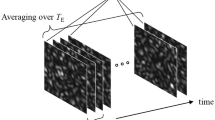Abstract
To evaluate the influence of exposure time on speckle noise for laser displays, speckle contrast measurement method was developed observable at a human eye response time using a high-sensitivity camera which has a signal multiplying function. The nonlinearity of camera light sensitivity was calibrated to measure accurate speckle contrasts, and the measuring lower limit noise of speckle contrast was improved by applying spatial-frequency low pass filter to the captured images. Three commercially available laser displays were measured over a wide range of exposure times from tens of milliseconds to several seconds without adjusting the brightness of laser displays. The speckle contrast of raster-scanned mobile projector without any speckle-reduction device was nearly constant over various exposure times. On the contrary to this, in full-frame projection type laser displays equipped with a temporally-averaging speckle-reduction device, some of their speckle contrasts close to the lower limits noise were slightly increased at the shorter exposure time due to the noise. As a result, the exposure-time effect of speckle contrast could not be observed in our measurements, although it is more reasonable to think that the speckle contrasts of laser displays, which are equipped with the temporally-averaging speckle-reduction device, are dependent on the exposure time. This discrepancy may be attributed to the underestimation of temporal averaging factor. We expected that this method is useful for evaluating various laser displays and clarify the relationship between the speckle noise and the exposure time for a further verification of speckle reduction.












Similar content being viewed by others
References
Trisnadi, J.I.: Speckle contrast reduction in laser projection displays. Proc. SPIE 4657, 131–137 (2002)
Roelandt, S., Meuret, Y., Craggs, G., Verschaffelt, G., Janssens, P., Thienpont, H.: Standardized speckle measurement method matched to human speckle perception in laser projection systems. Opt. Express 20, 8770–8783 (2012)
Kubota, S.: Simulating the human eye in measurements of speckle from laser-based projection displays. Appl. Opt. 53, 3814–3820 (2014)
Kubota, S., Goodman, J.W.: Very efficient speckle contrast reduction realized by moving diffuser device. Appl. Opt. 49, 4385–4391 (2010)
Fukui, T., Ito, K., Suzuki, K., Tokita, H., Furukawa, Y., Kubota, S.: 1st Laser Display Conf. Dig. Tech. Pap. LDC8-3, Laser Dispay Conference, Yokohama (2012)
Suzuki, K., Fukui, T., Kubota, S., Furukawa, Y.: Verification of Speckle Contrast Measurement Interrelation with Observation Distance. Opt. Rev. 21, 94–97 (2014)
Fukui, T., Suzuki, K., Kubota, S.: Proc. IDW’13, PRJ4-1. The Institute of Image Information and Television Engineers and The Society for Information Display, pp. 1251–1254. Sapporo (2013)
Fukui, T., Suzuki, K., Kubota, S.: Proc. IDW’14, PRJ3-2. The Institute of Image Information and Television Engineers and The Society for Information Display, pp. 1094–1097. Niigata (2014)
Gakkai, S.: Hikari no keisoku manual, p. 404. Tokyo, Nihon Riko Shuppankai (1990). (in Japanese)
Xu, M., Shi, Y., Tang, G., Liu, J., Chen, X.: World academy of science, engineering and technology. Int. J. Math. Comput. Phys. Electr. Comput. Eng. 6(3), 261–264 (2012)
Li, D., Kelly, D.P., Sheridan, J.T.: Speckle suppression by doubly scattering systems. Appl. Opt. 52, 8617–8626 (2013)
Goodman, J.W.: Speckle Phenomena in Optics. Roberts & Company, Colorado (2007)
Ma, Q., Xu, C.: 4th Laser Display and Lighting Conf. Dig. Tech. Pap., LDC 7–2. Laser Display Conference. Yokohama (2015)
Digital-Gazou-Syori Hensyu-iinkai: Digital Image Processing, p. 204. Computer Graphic Arts Society, Tokyo (2004). (in Japanese)
Piederrière, Y., Cariou, J., Guern, Y., Le Jeune, B., Le Brun, G., Lotrian, J.: Scattering through fluids: speckle size measurement and Monte Carlo simulations close to and into the multiple scattering. Opt. Express 12, 176–188 (2004)
Author information
Authors and Affiliations
Corresponding author
Ethics declarations
Conflict of interest
On behalf of all authors, the corresponding author states that there is no conflict of interest.
Appendix
Appendix
The cross-correlation was calculated by the following method. In [14], a zero-mean normalized cross-correlation is expressed by
where I (i, j) is a digital number of the original image, T (i, j) is a digital number of the template image with the size of M × N pixels, and the position of (i, j) is the address of template image in which the value of i is from 0 to M − 1 and the value of j is from 0 to N − 1. The values of \(\overline{I}\) and \(\overline{T}\) are expressed by
In this work, the maximum value of R ZNCC with the template image size of 128 × 128 was calculated by shifting every one pixel from the perfectly matched position between the original image and the template image to ± 128 pixels, and we plotted the maximum value as the cross-correlation R CC in Figs. 9, 10 and 11. As a result, the value of R CC was the same as the R ZNCC at the perfectly matched position.
We calculated the speckle average grain size defined as an FWHM of the normalized auto-covariance function [15], which is expressed by
where I (x, y) is a digital number of the captured image at the position of (x, y), and FT and FT−1 are Fourier and inverse Fourier Transform, respectively. \(\langle \rangle\) is a spatial average. We plotted the FWHM of Eq. (A4) as S in Figs. 9, 10 and 11.
Rights and permissions
About this article
Cite this article
Suzuki, K., Kubota, S. Understanding the exposure-time effect on speckle contrast measurements for laser displays. Opt Rev 25, 131–139 (2018). https://doi.org/10.1007/s10043-017-0372-5
Received:
Accepted:
Published:
Issue Date:
DOI: https://doi.org/10.1007/s10043-017-0372-5




